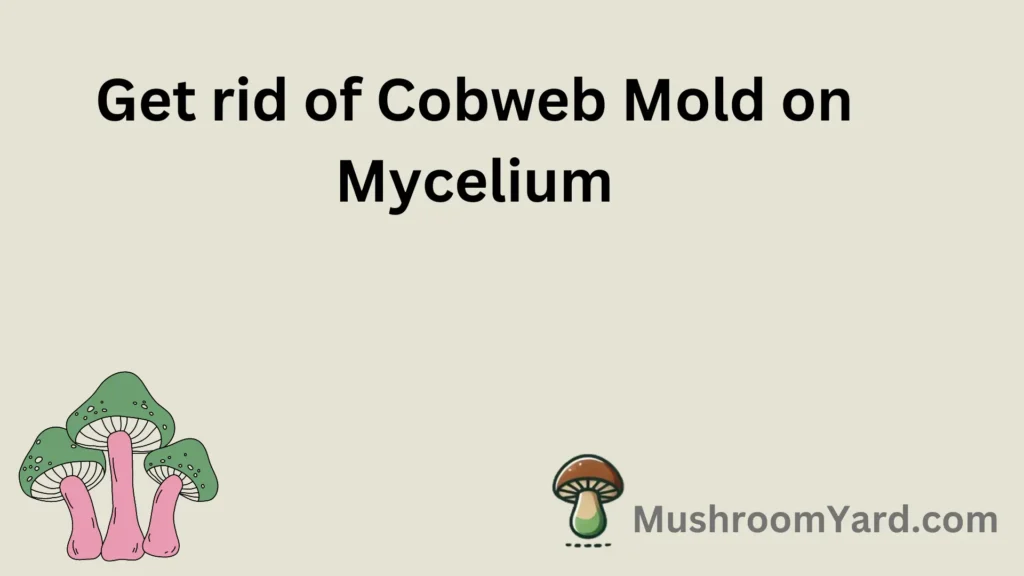

Cobweb mold is every mushroom grower’s nightmare. It grows rapidly and can easily overshadow mycelium, often leaving cultivators frustrated. But, don’t worry—there are effective ways to tackle this issue and save your mushroom crop. Hi, I am Clara and today I will talk about how to get rid of cobweb mold on Mycelium. At the end of this article, I will share my personal experience that I faced for the first time with cobweb mold 9 years ago.
Cobweb Mold spreads aggressively over the substrate and mycelium, often covering them in just a few days. So it’s really important to get rid of Cobweb Mold if you want good mushroom harvesting.
“Cobweb mold spreads so fast that ignoring it for even a day can cost you your entire crop,” says a seasoned cultivator.
This article will only focus on getting rid of cobweb mold. So if you want to learn more about cobweb mold and identification I suggest you check my previous article: Cobweb Mold on Mushrooms: Identification, Prevention, and Control
In that previous article, I could not cover the removal process in depth so I am here again with another article.
You should also be aware of the difference between mold and mycelium because mycelium is necessary and molds should be removed.
Boost Air Circulation: Cobweb mold can grow and spread in stagnant conditions. Make sure your growing environment has sufficient airflow. You don’t need extreme measures—just a gentle flow of fresh air should help reduce the chance of mold formation.
Quote: “Airflow is your first line of defense. Without it, you’re inviting cobweb mold in,” shares an expert grower.
Use Hydrogen Peroxide: A simple 3% hydrogen peroxide solution can work wonders. Mist the affected areas lightly with hydrogen peroxide to kill off the mold without harming your mycelium. Make sure not to drench the substrate, as excess moisture could further fuel mold growth.
Tip: Spritzing twice a day until the cobweb mold is under control usually does the trick.
Adjust Humidity Levels: While mushrooms need a humid environment, too much humidity can fuel cobweb mold. Aim for a humidity level of around 85-90%. Anything above 95% might create an overly damp setting that favors mold.
Sterilize Tools and Work Area: After spotting cobweb mold, it’s essential to clean and sterilize the tools you’ve used. Contamination can easily spread if you’re reusing tools without proper cleaning.
Pro Tip: Use rubbing alcohol or a diluted bleach solution to wipe down surfaces and tools regularly.
Increase Lighting: Cobweb mold dislikes light, particularly UV light. Consider increasing light exposure in your growing environment or placing the affected area under a UV lamp for a few minutes daily. This will inhibit mold growth without harming your mushrooms.
I am not doing affiliate marketing here thus I will not include any buying links. But you can search on Google for the UV lamp and after checking the reviews you can buy one. Believe me, it will be useful for your mushroom cultivation.
Dealing with cobweb mold was a lesson I learned the hard way. In my early days of mushroom cultivation, I didn’t pay enough attention to air circulation. One morning, I walked into my grow room and noticed this fuzzy, greyish layer creeping across my mycelium. At first, I thought it was just more mycelium growing, but something felt off. It was spreading fast—way too fast.
I remember feeling that sinking feeling in my gut. I had worked so hard to get the mycelium healthy, and here was this invader threatening to ruin it all. A quick Google search confirmed my fears—cobweb mold.
The first thing I did was grab a bottle of 3% hydrogen peroxide (thankfully, I had some on hand). I lightly misted the moldy areas, watching as the peroxide fizzled and dissolved the mold. That was a satisfying moment. But I knew the job wasn’t done. I increased airflow by cracking open the windows and placing a small fan nearby, just to keep the air moving.
I spent the next few days constantly checking on my grow. Each time I spotted even a hint of cobweb mold, I sprayed it with peroxide. It took a few days, but eventually, the mold was gone, and my mycelium recovered.
What I Learned: Prevention is everything. Now, I’m much more careful about ventilation and humidity, and I always keep a close eye on my growth during those critical early stages. Cobweb mold is sneaky, but with the right tools and a bit of diligence, you can definitely beat it. (If I can, you can too)
If you can remove cobweb mold from your mushrooms you can increase harvesting.
Also read: Top 10 Most Profitable Mushroom Varieties to Grow